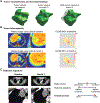Identification of Non-Small Cell Lung Cancer Sensitive to Systemic Cancer Therapies Using Radiomics
- PMID: 32198149
- PMCID: PMC9239371
- DOI: 10.1158/1078-0432.CCR-19-2942
Identification of Non-Small Cell Lung Cancer Sensitive to Systemic Cancer Therapies Using Radiomics
Abstract
Purpose: Using standard-of-care CT images obtained from patients with a diagnosis of non-small cell lung cancer (NSCLC), we defined radiomics signatures predicting the sensitivity of tumors to nivolumab, docetaxel, and gefitinib.
Experimental design: Data were collected prospectively and analyzed retrospectively across multicenter clinical trials [nivolumab, n = 92, CheckMate017 (NCT01642004), CheckMate063 (NCT01721759); docetaxel, n = 50, CheckMate017; gefitinib, n = 46, (NCT00588445)]. Patients were randomized to training or validation cohorts using either a 4:1 ratio (nivolumab: 72T:20V) or a 2:1 ratio (docetaxel: 32T:18V; gefitinib: 31T:15V) to ensure an adequate sample size in the validation set. Radiomics signatures were derived from quantitative analysis of early tumor changes from baseline to first on-treatment assessment. For each patient, 1,160 radiomics features were extracted from the largest measurable lung lesion. Tumors were classified as treatment sensitive or insensitive; reference standard was median progression-free survival (NCT01642004, NCT01721759) or surgery (NCT00588445). Machine learning was implemented to select up to four features to develop a radiomics signature in the training datasets and applied to each patient in the validation datasets to classify treatment sensitivity.
Results: The radiomics signatures predicted treatment sensitivity in the validation dataset of each study group with AUC (95 confidence interval): nivolumab, 0.77 (0.55-1.00); docetaxel, 0.67 (0.37-0.96); and gefitinib, 0.82 (0.53-0.97). Using serial radiographic measurements, the magnitude of exponential increase in signature features deciphering tumor volume, invasion of tumor boundaries, or tumor spatial heterogeneity was associated with shorter overall survival.
Conclusions: Radiomics signatures predicted tumor sensitivity to treatment in patients with NSCLC, offering an approach that could enhance clinical decision-making to continue systemic therapies and forecast overall survival.
©2020 American Association for Cancer Research.
Conflict of interest statement
Disclosure of Potential Conflicts of Interest
M. Fronheiser is an employee for Bristol-Myers Squibb. S. Du is an employee for Bristol-Myers Squibb. W. Hayes is an employee for and holds ownership interest (including patents) in Bristol-Myers Squibb. D.K. Leung is an employee for Bristol-Myers Squibb. A. Roy is an employee for and holds ownership interest (including patents) in Bristol-Myers Squibb. L.H. Schwartz is a paid advisory board member for Roche and Novartis, and reports receiving commercial research grants from Merck and Boehringer Ingelheim. No potential conflicts of interest were disclosed by the other authors.
Figures




References
-
- Yamamoto S, Korn RL, Oklu R, Migdal C, Gotway MB, Weiss GJ, et al. ALK molecular phenotype in non-small cell lung cancer: CT radiogenomic characterization. Radiology 2014;272:568–76. - PubMed
-
- Kim TJ, Lee CT, Jheon SH, Park JS, Chung JH. Radiologic characteristics of surgically resected non-small cell lung cancer with ALK rearrangement or EGFR mutations. Ann Thorac Surg 2016;101:473–80. - PubMed
-
- Zhou JY, Zheng J, Yu ZF, Xiao WB, Zhao J, Sun K, et al. Comparative analysis of clinicoradiologic characteristics of lung adenocarcinomas with ALK rearrangements or EGFR mutations. Eur Radiol 2015;25:1257–66. - PubMed
-
- Yang Y, Yang Y, Zhou X, Song X, Liu M, He W, et al. EGFR L858R mutation is associated with lung adenocarcinoma patients with dominant ground-glass opacity. Lung Cancer 2015;87:272–7. - PubMed

